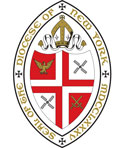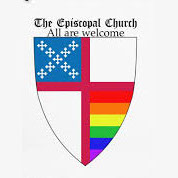Podcast: Play in new window | Download (Duration: 10:41 — 14.7MB)
Subscribe: Apple Podcasts | RSS
The Fifth Sunday in Lent
Watch the Sermon Here
Jeremiah 31:31-34
Hebrews 5:5-10
John 12:20-33
Psalm 51:1-13
Well, good morning, St Michael’s people! It’s lovely to be joining you live from London on a beautifully sunny, spring afternoon where it’s about a quarter past two in the afternoon.
We so value our partnership with you across the Atlantic and I have so many happy memories of my sabbatical with you back in 2017. I hope that Mother Kate has as refreshing a time on hers a little later this year
Today is what many of us in the Church still call Passion Sunday – the name traditionally given to the fifth Sunday of Lent – when our thoughts begin to turn more directly to the passion of Christ, shown in his liberating and life-giving death on the Cross of Calvary on Good Friday.
Because it’s when our thoughts begin to focus most directly on the cross it’s from this Sunday that we traditionally veil crosses and statues, although a number of churches following the Sarum tradition do so for the whole of Lent, which I think from watching some of your live-streamed Eucharists is what your practice is at St Michael’s.
Whenever it’s done, the veiling of crosses and images in church is a tradition which goes back many centuries and has its origin in the fact that many of the beautiful crosses and crucifixes in churches and monasteries were made out of precious materials like gold or silver and were elaborately encrusted with jewels as a sign of love and devotion to Christ.
It was felt that these precious and beautiful things should be covered up to reflect the sombre and poignant nature of the season, to be uncovered again with the unbridled festival joy of Easter.
I’m afraid I had to disappoint some of the people at Emmanuel this morning when I had to break the news to them that all the crosses and crucifixes in our church are made out of wood or brass, rather than gold or silver and there isn’t a diamond, ruby or precious stone in sight!
Nevertheless the tradition of veiling crosses and images has remained as a sign that the goal of our Lenten journey is the cross and the resurrection of Jesus in Holy Week
In one Anglo Catholic Church in which I served much earlier on in my ministry when I was just out of seminary, it was always said that you shouldn’t stand too still in Church on the Saturday before Passion Sunday in case Father, the parish priest, came along and veiled YOU, supposing you to be a statue..!
Now the Gospel which we’ve just heard and which signals the beginning of this season is Jesus’ great prediction of his passion in John Chapter 12.
It’s a response to a question from some Greeks who, in the excitingly cosmopolitan and diverse society of the time – rather like London or New York, were there eager to share in the joy of the impending festival.
In the New Testament, the term “Greeks” is often used in contrast to Jewish people as a shorthand for anyone and everyone else in the world.
So some of these Greeks come to Philip and say,
“Sir, we would see Jesus”.
It’s a phrase that in that same Anglo-Catholic parish I mentioned earlier was carved on to the pulpit stand, just above the preacher’s notes as a reminder to keep them focused..!
Philip tells Andrew and the two of them go to see Jesus to tell him the nature of the Greek’s request.
But the answer they are given is hardly chatty, convivial or light hearted.
“The hour has come”, Jesus replies, “for the Son of Man to be glorified. Very truly I tell you, unless a grain of wheat falls on the ground, it remains but a singly grain; buy if it dies it bears much fruit”.
Despite this acquired Metropolitan exterior, I’m a bit of a country-boy in so far as I was brought up on the land and my parents made a living out of growing tomatoes and lettuces commercially.
It was a familiar sight during my childhood of seeds being placed in the enriched and fertilised blocks to be inserted into the ground in order to germinate and thus become several months later the fully mature plants and fruit to be harvested and sent off to the London commercial markets.
And so it was that we saw what seemed an annual miracle of what was dead and lifeless being planted deep in the dark and cold of the ground being transformed into the magnificence of new life and new growth into the bold colours of the mature plants.
No wonder that it appears here in the Gospel of St John as such an evocative image of the liberating cycle of the death and resurrection of Jesus.
Now the theme of SIGNS OF THE GLORY of Jesus is something which we see running through the whole of John’s Gospel from which our reading this morning came – rather like the coloured writing going all the way through a stick of seaside rock.
In the much-loved reading at the conclusion of the Christmas Service of 9 lessons and Carols we hear from the first chapter of John’s Gospel, “And the word became flesh and dwelt among us and we have beheld his glory, the glory as of a father’s only begotten son”.
And just a Chapter later in the Epiphany season we hear at the conclusion of the miraculous transformation of water into wine at the wedding at Cana in Galilee, “this the first of his signs Jesus did at Cana of Galilee and manifested his GLORY, and his disciples believed in him”.
And so the sequence of signs runs all the way through the Gospel… right up to the greatest signs of all, through which his glory is revealed, in the cross of Calvary on that first Good Friday.
We haven’t yet got to that point either in the life of Jesus or in the church’s liturgical calendar, but today’s prediction of his death on the cross is vital, not only because it points us on our way, but far more significantly, because it shows us just how INCLUSIVE and UNIVERSAL the love of God shown to us in the warm embrace of Jesus Christ really is.
It’s all rather dramatic with a voice coming from heaven, accompanied by a clap of thunder (as is the context for many of the major pronouncements in the bible), but Jesus exclaims, “And I, when I am lifted up from the earth, will draw all people to myself!”
It’s a pronouncement which is in direct contrast with his reference at the beginning of the passage to the apparently dead seed being placed into the dark and cold of the earth to the bearing of much fruit at the end – for the cross which is universal and all inclusive is the fruit of God’s love in the world.
One of my great all-time heroes is ABp Desmond Tutu, a champion not only of the toppling of apartheid in South Africa, but as a prophetic voice both in the church and world of an end to marginalisation and discrimination of all oppressed groups.
In a well known public lecture which Tutu gave, he exclaimed, “When Jesus said, ‘When I am lifted up from the earth, he didn’t say I will draw some people to myself. No he said I will draw All! All! All! Black, white, men, women, straight, gay! He said I will draw everyone”.
For that is the mysterious glory of God’s love shown to us most powerfully in Jesus’ great embrace from the cross – lifted up, Jesus draws absolutely everyone to God’s heart of love, revealed most beautifully and radiantly in that earth-transforming, heaven-opening moment.
That, I believe, is the vocation of inclusive churches like Emmanuel and St Michael’s in our Church and world of today, who like ABp Desmond Tutu, are called fearlessly to witness to the God who in Christ is drawing everyone to himself, ending discrimination and prejudice and being fruits of that fearless love in our society today.
So as we reflect on Jesus, the seed planted in the ground which yields a rich harvest in his being lifted up from the earth, drawing everyone to himself, lets pledge ourselves to work for a more loving and a less prejudicial church and world —
until all things reflect his glory and the ultimate justice, compassion and mercy of God’s radical and eternal Kingdom. Amen.




